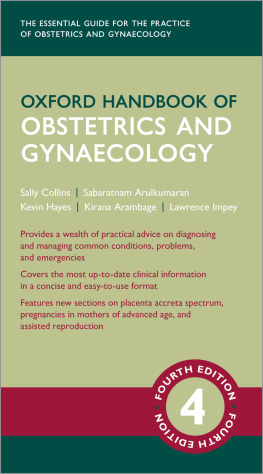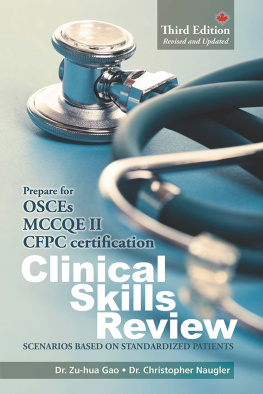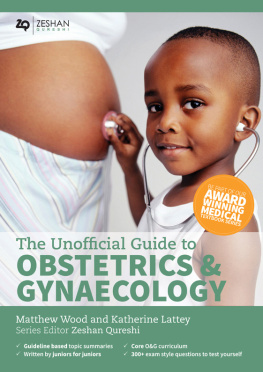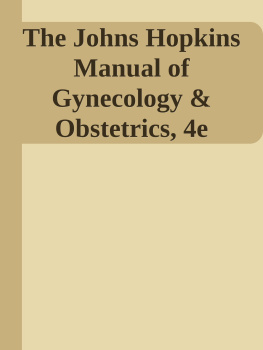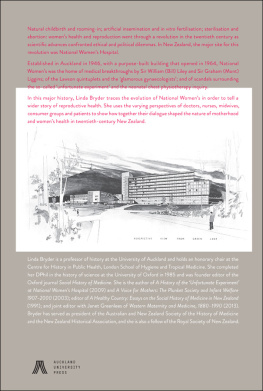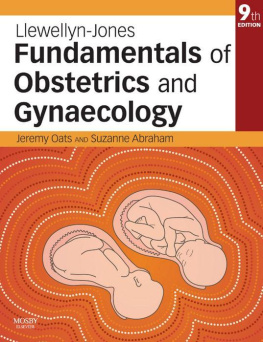Clinical Obstetrics & Gynaecology
Third Edition
Brian A. Magowan, MB, CHB, FRCOG, DIPFETMED Consultant Obstetrician and Gynaecologist, The Borders General Hospital, Melrose UK
Philip Owen, MB, BCH, MD FRCOG Consultant Obstetrician and Gynaecologist, Princess Royal Maternity Unit, Glasgow UK
Andrew Thomson, MB CHB, MRCOG, MD Consultant Obstetrician and Gynaecologist, Royal Alexandra Hospital, Paisley UK

Table of Contents
Dedication
This book is dedicated to the millions of women worldwide who will suffer disability, lose their babies or lose their lives through the want of adequate reproductive healthcare.
Copyright

2014 Elsevier Ltd. All rights reserved.
No part of this publication may be reproduced or transmitted in any form or by any means, electronic or mechanical, including photocopying, recording, or any information storage and retrieval system, without permission in writing from the publisher. Details on how to seek permission, further information about the Publishers permissions policies and our arrangements with organizations such as the Copyright Clearance Center and the Copyright Licensing Agency, can be found at our website: www.elsevier.com/permissions.
This book and the individual contributions contained in it are protected under copyright by the publisher (other than as may be noted herein).
First edition 2004
Second edition 2009
Third edition 2014
ISBN 978-0-7020-5408-2
International ISBN 978-0-7020-5409-9
e-book ISBN 978-0-7020-5410-5
British Library Cataloguing in Publication Data
A catalogue record for this book is available from the British Library
Library of Congress Cataloging in Publication Data
A catalog record for this book is available from the Library of Congress
Notices
Knowledge and best practice in this field are constantly changing. As new research and experience broaden our understanding, changes in research methods, professional practices, or medical treatment may become necessary.
Practitioners and researchers must always rely on their own experience and knowledge in evaluating and using any information, methods, compounds, or experiments described herein. In using such information or methods they should be mindful of their own safety and the safety of others, including parties for whom they have a professional responsibility.
With respect to any drug or pharmaceutical products identified, readers are advised to check the most current information provided (i) on procedures featured or (ii) by the manufacturer of each product to be administered, to verify the recommended dose or formula, the method and duration of administration, and contraindications. It is the responsibility of practitioners, relying on their own experience and knowledge of their patients, to make diagnoses, to determine dosages and the best treatment for each individual patient, and to take all appropriate safety precautions.
To the fullest extent of the law, neither the publisher nor the authors, contributors, or editors, assume any liability for any injury and/or damage to persons or property as a matter of products liability, negligence or otherwise, or from any use or operation of any methods, products, instructions, or ideas contained in the material herein.



Printed in China
Foreword
James Drife Leeds
Seeing this book reach its third edition, only nine years after it first appeared, makes me feel like a proud dad on graduation day. I can take only a small share of the credit for its success but at least I was there at the conception.
The books long gestation began twenty years ago when, as recently-appointed professor, I invited colleagues to contribute to a new textbook suitable for the 1990s. This was a time when pocket-sized books were popular and e-mail was not yet routine. My letters explained that ours would be larger than the textbooks used by most students at present and that the publishers had approved the proposal with great enthusiasm.
When weighty envelopes started arriving in the post, I began to appreciate the size of the task. Uniformity of style had to be achieved and the university lecturers rallied round to help with the editing. They identified gaps in the contents list and new invitations were issued. My ambitious plan for a problem-based section had to be dropped: it is surprisingly difficult for doctors to explain on paper how we make our intuitive decisions.
Deadlines came and went, testing the publishers enthusiasm almost to breaking point. Labour ward duties, university work and Royal College responsibilities are not a recipe for swift and efficient editing. It became clear that the book was suffering the literary equivalent of an obstructed labour and may even be stillborn. It was time to call for obstetric help.
Very fortunately, Brian Magowan, with a track record of successful deliveries, agreed to become co-editor. As a bonus, his academic centre was my alma mater and the book became a Leeds/Edinburgh co-production. He and his colleagues wrote the final chapters, allowing the publishers to unleash the talents of designers and illustrators, in the style of Kumar and Clarks splendid textbook of clinical medicine. Their combined efforts brought us the Society of Authors and Royal Society of Medicines Highly Commended certificate, still framed beside my desk.
For the second edition, Brian and I were joined by Philip Owen, one of my fellow-editors of the European Journal of Obstetrics & Gynaecology and Reproductive Biology . Our team of authors became national, indeed international, and with their input, the book matured and began to develop a life of its own. I could retire happy, knowing that future editions were in the safest of hands. It is also now a real pleasure to welcome Andrew Thomson as joint editor for this, the third, edition.
What makes any project worthwhile is the feeling that you may actually be doing some good. For me, the real reward comes from occasional chance remarks by young doctors on how the book helped them and perhaps even inspired them. One page that has remained constant across the first three editions is the books Dedication, to the many women worldwide who still need better care. There is a job to be done, and it feels good to have been part of the outstanding team who are helping tomorrows doctors to do it.
Preface
BM; PO; AT
So much has changed since the first edition of this book that we have involved a comprehensive group of experts to ensure that this new edition is up to date and relevant.
What remains constant, however, is the many challenges that obstetrics and gynaecology offer. From the ethics of assisted conception treatments through the global importance of contraception, the challenges of gynaecological cancer care and the dilemmas of prenatal diagnosis, to mention but a few, there are many issues with which to become familiar.


